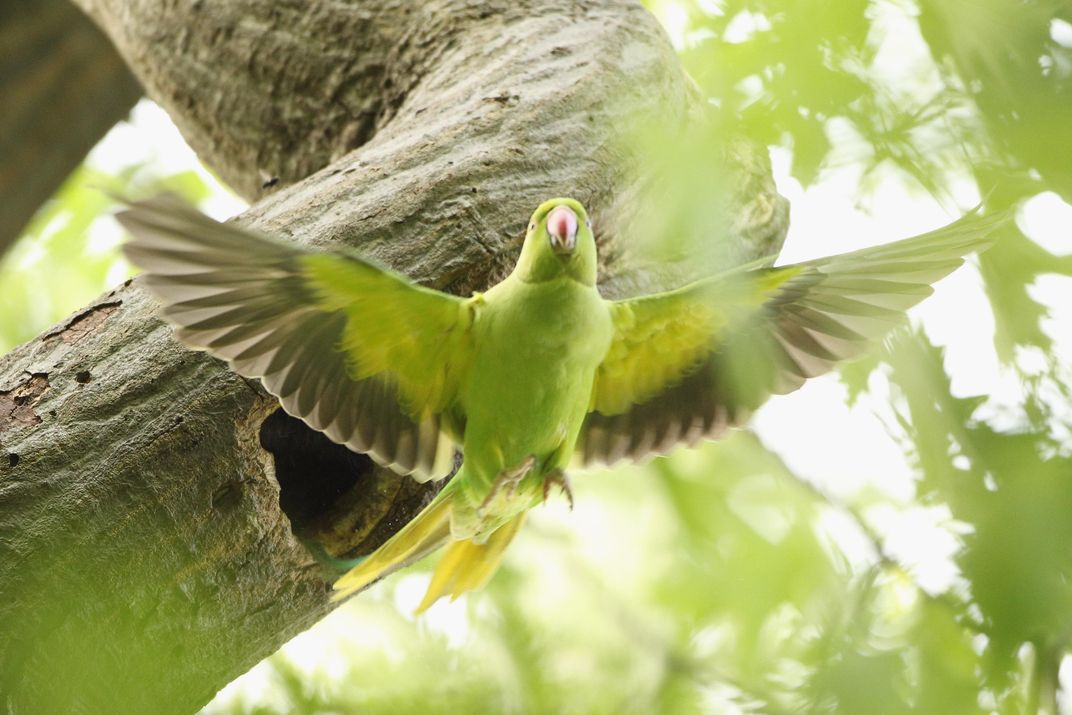Contrary to Popular Legend, Jimi Hendrix Did Not Introduce an Invasive Parakeet to the U.K.
A new study debunks several colorful theories about how ring-necked parakeets became the most abundant naturalized parrot across the pond
/https://tf-cmsv2-smithsonianmag-media.s3.amazonaws.com/filer/31/06/3106caad-32ea-4faf-ad23-10b788152cb5/gettyimages-89203518.jpg)
Take a stroll through a British park, and you may spot an unusual avian creature flitting among the sparrows and pigeons: the ring-necked parakeet, a vibrant green bird native to arid, tropical climates. Known in scientific circles as Psittacula krameri, the parakeet is a highly successful invasive species—it is, in fact, the most abundant naturalized parrot in the United Kingdom—and how it came to colonize the European nation has been the subject of much colorful debate.
Some speculate that the birds escaped from the set of The African Queen, a 1951 movie starring Humphrey Bogart and Katherine Hepburn that was shot at Worton Hall Studios in Isleworth. Others blame musician Jimi Hendrix, who purportedly released two parakeets on Carnaby Street in London in 1968. Still others say that during the 1970s, debris from an aircraft fell onto an aviary at Syon Park in West London, freeing the ring-necks that had been housed there.
According to a new study published in the Journal of Zoology, all of these theories are for the birds. Using a statistical technique originally developed to map possible perpetrators of violent crimes, the researchers laid out a simpler hypothesis of how ring-necked parakeets made their home across the pond: Over the decades, the study suggests, pet birds were repeatedly released into the wild—sometimes accidentally, sometimes on purpose.
Led by the late Steven Le Comber, a senior lecturer at the Queen Mary University of London who died in September of this year, the researchers drew on records logged in the National Biodiversity Network Atlas to analyze patterns of ring-neck sightings between 1968 and 2014. The team was specifically looking to see if locations associated with the parakeets’ release—particularly Worton Hall, Carnaby Street and Syon Park—corresponded to priority areas isolated by the analysis, which was conducted via geographic profiling. This technique, according to the Queen Mary University of London, is typically used by police to map crime sites, like the locations of homicide victims’ bodies.
“This is overlaid on a map of the area of interest to produce a geoprofile and narrow down the area where the perpetrator is likely to live or work,” the university explains.

In recent years, scientists have used geographic profiling to map the locations of invasive species and pinpoint the areas from which they likely spread. In the case of the ring-necked parakeets, the results were clear: “Spatial analysis shows no support for any of the popular theories about the introduction of P. krameri to the U.K.,” the study authors write. “None of the supposed sites of introduction show up prominently in the geoprofiles.”
The researchers weren’t surprised by this finding; ornithologists have long believed that ring-necked parakeets likely became established in the U.K. after people repeatedly released their pets into the wild.
Still, the team conducted a detailed search of the British Newspaper Archive in order to supplement their geographic analysis. The researchers found numerous reports of ring-necked parakeet sightings in the wild, some of them dating back to the 1800s—long before Jimi Hendrix and a careless film studio are said to have unleashed the birds onto the British public. There was, in fact, no contemporary reporting on these theories; the oldest media account that mentions Hendrix and The African Queen appeared in BBC News in 2005.
Archival records also offered insights on how pet ring-necked parakeets may have ended up outside their homes. The researchers found numerous accounts of accidental releases, including one 1955 newspaper article that chronicled the escape of 140 “foreign caged birds” in Wales. But it seems likely that many of the feathery friends were released on purpose. In 1929 and 1930, there was a global outbreak of psittacosis, an infectious disease that can be transferred from birds to humans. The disease was first reported in England, and some 800 people around the world were ultimately affected.
The British press ran wild with the story, publishing a number of sensational accounts about “parrot fever.” “Risk run by keeping parrots,” the Western Daily Press proclaimed in 1929. Under the headline “Parrot don’ts,” a 1929 article in the Lancashire Evening Post, reported that authorities in Berlin had advised bird people “not to allow parrots to kiss or bite them.” And the U.K.’s Ministry of Health banned bird imports for the next two centuries, leaving people who already owned pet parrots faced with the problem of what to do with the them.
“It is easy to imagine [these] headlines leading to a swift release of pets,” study co-author Sarah Elizabeth Cox tells Hannah Devlin of the Guardian. “If you were told you were at risk being near one, it would be much easier to let it out the window than to destroy it.”
The study authors acknowledge that, in spite of the evidence against popular theories about ring-necked parakeets’ introduction to the U.K., these urban legends “will probably not be dispelled quickly.” But the researchers note that P. krameri does very well when introduced to non-native habitats, albeit often to the detriment of native species and crops.
“Certainly, in the other 34 countries on five continents in which P. krameri has been recorded as an invasive,” the study authors write, “it has not needed the help of either rock stars or movie stars to become established.”